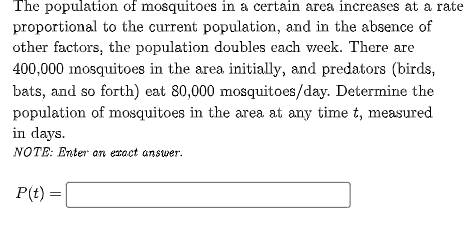The population of mosquitoes in a certain area increases at a rate proportional to the current population, and in the absence of other factors, the population doubles each vweck. There are 400,000 mosquitoes in the area initially, and predators (birds, bats, and so forth) eat 80,000 mosquitoes/day. Determine the population of mosquitoes in the area at any time t, measured in days. NOTE: Enter an exact answer. P(t) =
The population of mosquitoes in a certain area increases at a rate proportional to the current population, and in the absence of other factors, the population doubles each vweck. There are 400,000 mosquitoes in the area initially, and predators (birds, bats, and so forth) eat 80,000 mosquitoes/day. Determine the population of mosquitoes in the area at any time t, measured in days. NOTE: Enter an exact answer. P(t) =
Linear Algebra: A Modern Introduction
4th Edition
ISBN:9781285463247
Author:David Poole
Publisher:David Poole
Chapter7: Distance And Approximation
Section7.3: Least Squares Approximation
Problem 33EQ
Related questions
Question
Please Help ASAP!!!

Transcribed Image Text:The population of mosquitoes in a certain area increases at a rate
proportional to the current population, and in the absence of
other factors, the population doubles each vweek. There are
400,000 mosquitoes in the area initially, and predators (birds,
bats, and so forth) eat 80,000 mosquitoes/day. Determine the
population of mosquitoes in the area at any time t, measured
in days.
NOTE: Enter an eract answer.
P(t) =
Expert Solution
This question has been solved!
Explore an expertly crafted, step-by-step solution for a thorough understanding of key concepts.
Step by step
Solved in 4 steps

Recommended textbooks for you

Linear Algebra: A Modern Introduction
Algebra
ISBN:
9781285463247
Author:
David Poole
Publisher:
Cengage Learning

Algebra & Trigonometry with Analytic Geometry
Algebra
ISBN:
9781133382119
Author:
Swokowski
Publisher:
Cengage

Linear Algebra: A Modern Introduction
Algebra
ISBN:
9781285463247
Author:
David Poole
Publisher:
Cengage Learning

Algebra & Trigonometry with Analytic Geometry
Algebra
ISBN:
9781133382119
Author:
Swokowski
Publisher:
Cengage